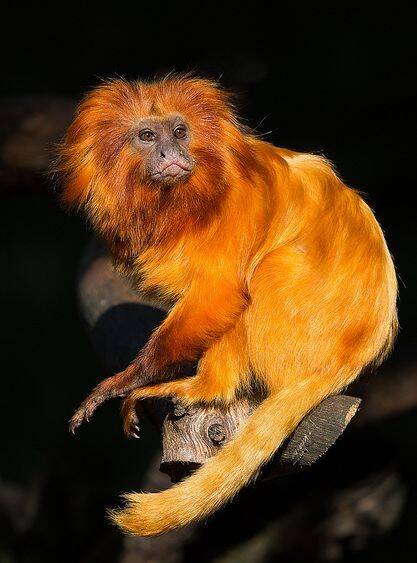Leontopithecus rosalia
IUCN
LCBasic Information
Scientific classification
- name:Leontopithecus rosalia
- Scientific Name:Leontopithecus rosalia,Golden Lion Tamarin
- Outline:Primates
- Family:Marmoset L.Tamarin
Vital signs
- length:25-33cm
- Weight:400-800g
- lifetime:No verification information
Feature
The whole body is covered with golden velvety soft long hair
Distribution and Habitat
Distributed along the Atlantic coast of southeastern Brazil. The golden lion tamarin was once found throughout Rio de Janeiro and Espirito Santo states, but by 1981, less than 900 square kilometers of the state were recorded. It is isolated and divided into 17 subpopulations in suitable habitats.
The wild habitat is mainly tropical virgin forests. It is usually active in the middle and canopy layers of large trees 3-10 meters above the ground, and lives among the intertwined branches under the cover of dense vines and other parasitic plants.
Appearance
The head and body length of the golden lion tamarin is 25-33 cm, the tail is 32-40 cm long, and the weight is 400-800 grams. It is the largest among marmosets. It is small and exquisite, with golden velvety soft hair all over its body, shining and eye-catching. The lion-like crown on its head brushes against its back, its mouth protrudes forward, and its ears are hidden under the hair. It looks dignified and majestic, just like a little lion, very beautiful and moving. Its body and feet are longer than those of other marmosets. There is a membrane connecting the second, third and fourth fingers to form a webbed shape. Except for the thumb, all other fingers (toes) have sharp claws. It has 32 teeth in total, with long "fangs" on the lower jaw, and the length of the incisors and canines is almost equal.
Details
Golden Lion Tamarin (scientific name: Leontopithecus rosalia) is also known as Golden Lion Tamarin in English. There are no subspecies. There are about 1,000 Golden Lion Tamarins in the wild and 500 in captivity.

Golden lion tamarins are diurnal arboreal animals. They are active and lively, with keen vision, hearing and smell. They are agile and extremely agile. They can leap from one tree to another tree far away in an instant, or run quickly along the trunks and branches. Some of their difficult movements are not only difficult for other monkeys to complete, but even squirrels cannot catch up. Lion tamarins usually live in small-scale family-style groups, with 2-8 in each group, and 3-4 is the most common. Most of them are a pair of adults and their cubs, often gathering together to comb each other's beautiful golden long hair. They sleep in tree holes every night. Because the hole is very narrow, ordinary carnivores cannot enter, which can effectively avoid enemies. The tree hole is also covered with golden soft hair pulled from its body, which is both beautiful and comfortable, so a tree hole can be used for its habitat for many years.
Golden lion tamarins are omnivorous animals, foraging for various insects, spiders, moths, flies, grubs, worms, and tender shoots, flowers and fruits of various plants, etc. They especially like to eat figs. Sometimes they dig earthworms and small lizards on the ground, and sometimes they forage for bird eggs in trees, and even prey on newly born birds. In addition, in the forest where it lives, many tree trunks or branches are covered with large and small holes. This is because it likes to suck the sap of trees. It often uses its sharp claws to dig holes in the trunks or branches, or bites with its powerful incisors, and then sucks the sap flowing out into its mouth with relish.
The breeding season of golden lion tamarins is concentrated from September to March of the following year, that is, from early spring to late summer, which is the most humid and hot season in the area. The gestation period of females is 125-134 days, and each litter has 1-3 cubs, but 2 cubs are the most common. The cubs are mostly taken care of by males, and they can move independently after growing to 3 months.
Most South American countries have banned or limited exports and established national parks and nature reserves to effectively protect these rare species. For example, Brazil has stopped exporting lion tamarins since 1969 and has significantly increased the scope of protection for primates. Despite this, the future of these beautiful little primates remains worrying.
Listed in the IUCN Red List of Threatened Species in 2008 ver 3.1 - Endangered (EN).
Listed in Appendix I of the Washington Convention on International Trade in Endangered Species (CITES).
Protect wildlife and eliminate game.
Maintaining ecological balance is everyone's responsibility!








